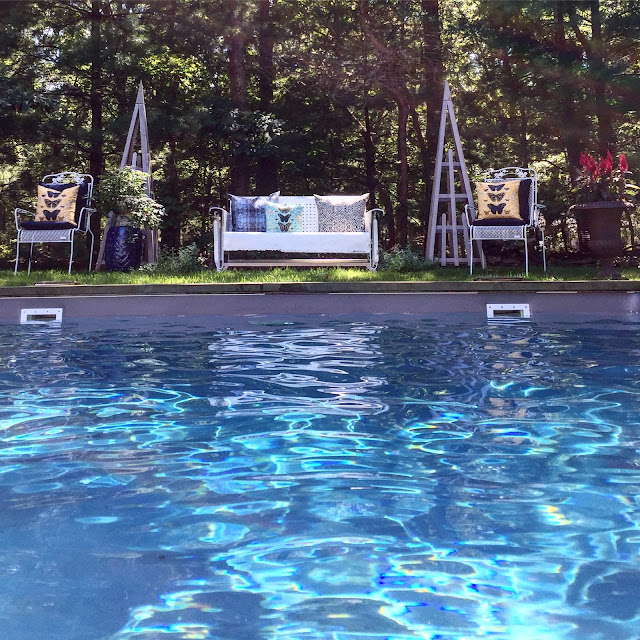WHY IN DESIGN COLUMN: the history of Cross Stitch, plus a new Wallpaper Collection has me singing my ABCs
antique German cross-stitch; photo courtesy Wikipedia
Sampler, Elizabeth Short, 1661 exhibited at V&A Museum in London
Let's Talk Cross Stitching, Shall We?
This antique decorative art form was created as far back
as during ancient Egypt and is still popular today.
"Cross-stitch is a popular form of counted-thread embroidery in which X-shaped stitches in a tiled, raster-like pattern are used to form a picture. Cross stitch is often executed on easily countable even weave fabric called aida cloth. The stitcher counts the threads in each direction so that the stitches are of uniform size and appearance. This form of cross stitch is also called counted cross-stitch in order to distinguish it from other forms of cross-stitch. Sometimes cross-stitch is done on designs printed on the fabric (stamped cross-stitch); the stitcher simply stitches over the printed pattern".
~Wikipedia~
These designs were made all over the world, and today examples are displayed in many museums, showing it as the oldest form of embroidery. First samples of cross-stitch were designed in cross patterns on linen fabric, and one of the earliest pieces was found in a Coptic tomb in Egypt. It was preserved by the arid climate and is believed to have been created around 500 BC. The Celtics created cross stitching way back as well. It is also thought the Chinese perfected the decorative art form during the T'ang Dynasty from 600-900 AD. Many ancient temples and churches boast examples of cross stitching, and examples can be seen on antique traditional garb as well from the Middle East and beyond. The decorative art spread throughout Europe, with the first cross-stitch pattern book released in Germany in the 1500s. Because the first books were printed in black and white there left lots to the stitcher's imagination for bringing in color. Due to international trading of home products, cross stitching designs became popular all over the world. These trades influenced artists and helped to create the "melting pot" designs we see today pulling from many cultures.
Here in the States the cross-stitch sampler became popular during the early settler days with a basic pattern often created by a young girl learning the trade and in alphabet designs to be used in the home for various practical purposes on linens. Stitchers would sometimes add other items such as animals and household images to the pattern, creating their own personal signature. There are examples of early United States cross-stitch sample pieces created in Massachusetts, including an example noted at Pilgrim Hall in Plymouth by Loara Standish, the daughter of famous early settler, Captain Myles Standish in circa 1653. This ancient decorative art then was printed with vigor during the mid 1800s until the invention of the sewing machine in the 1850s when popularity waned for a bit. There was another surge in popularity in the 1960s when artisan made products became appreciated again for their craftsmanship, and again in the 1980s. Today the designs are appreciated for their historical value and the beautiful, handmade quality.
cross-stitch sampler from 1815 by Jane Knowles
via NoonMarkAntiques
On that note, I am smitten with this brand new wallpaper pattern which depicts this technique and called Cross Stitch by designer and stylist Abigail Edwards who was inspired by embroidery books she found at Parisian flea markets. The new collection comes in two colorways paying homage to antique embroidery and cross-stitch patterns. The simple monochrome scheme gives the intricate design a graphic quality with the design featuring alphabet symbols in different fonts and folkloric animal designs, creating a graphic and modern aesthetic. Abigail hand draws all of the designs, then prints them in the UK on FSC certified paper and non-toxic water based inks.
I met Abigail Edwards at Tent London in 2011 just as one of her first wallpaper collections was launched. You may remember I reported about her fabulous Owls of The British Isle wallpaper which launched that year. The timing of the design came on the cusp of the now owl craze in the design industry over the past couple of years. Other wallpapers in Abigail Edward's collections include Storm Clouds, Brambleweb, Wilson’s Crystals, Seascape and Briar Owl.
Happy Nesting
XO Tamara
Photograph credit for Abigail Edward's photographs, Alun CallenderWikipedia, classiccrossstitch.com, loarastandishsampler, Abigail Edwards, love-cross-stitch.com
Cross Stitch wallpaper is available in 10m x 52cm rolls
and in black on white color or Candy color.










